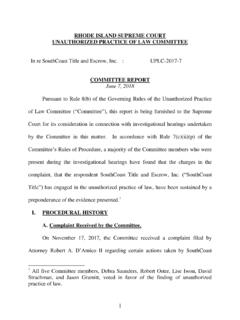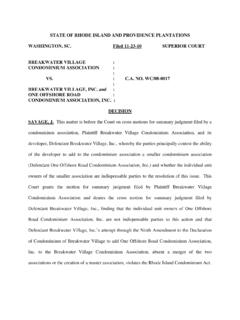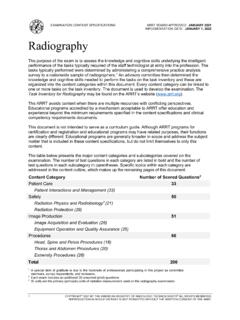Transcription of PROTOCOLS FOR INJURIES TO THE FOOT AND ANKLE
1 PROTOCOLS FOR INJURIES TO THE FOOT AND ANKLE I. digital FRACTURES A. Background digital fractures commonly occur in the workplace and are usually the result of a crush injury from a falling object, or from striking one's foot against an immobile object (stubbing one's toe). There is a wide range of digital fractures, from simple non-displaced fractures requiring stiff soled shoe wear, to comminuted compound intra-articular fractures requiring emergent surgical debridement and stabilization. Minimizing digital fracture occurrence should be the primary goal in the workplace, and the steel toe "safety shoes" has significantly reduced the incidence of these INJURIES . B. Diagnostic Criteria 1. History and Physical Examination: i.
2 Typically, the patient presents with a painful, swollen toe. The patient often complains of difficulty with shoe wear and ambulation. ii. Physical exam reveals swelling, erythema and ecchymosis at the injured digit, which can often extend into the forefoot. Palpating the injured digit reproduces the pain. 2. Diagnostic Imaging: i. Plain radiography : Standard antero-posterior (AP), oblique, and lateral radiographs of the entire foot should be obtained to not only include the toe, but the entire foot as INJURIES more proximal are common. ii. Bone Scan: Not indicated. iii. CT Scan: Not indicated. iv. MRI: Not indicated. C. Treatment based on Fracture Type 1. Lesser Digit Fractures 2nd -5th toe fractures: i.
3 Extra-articular fractures 1. Non-displaced: Buddy splint with post op shoe or short CAM walker depending on patient comfort level for 2-4 weeks. 2. Displaced: Closed reduction under digital anesthetic block followed by buddy splint, post-op shoe, or short CAM walker boot for 4-6 weeks require evaluation by orthopedic surgeon or podiatrist in cases of severe displacement or painful non-union. ii. Intra-articular fractures 1. Non-displaced: Buddy splint with post op shoe or short CAM walker depending on patient comfort level for 2-4 weeks. 2. Displaced: Closed reduction under digital anesthetic block followed by buddy splint, post-op shoe, or short CAM walker boot for 4-6 weeks. Require evaluation by orthopedic surgeon or podiatrist in cases of severe displacement or painful non-union that may require surgical intervention.
4 Iii. Open Fractures prophylaxis should be administered as soon as possible, with appropriate antibiotics. 2. Simple wounds can be irrigated and closed in the Emergency Department. 3. More complex wounds and crush INJURIES should be evaluated by an available orthopedic Surgeon or Podiatrist and often require operative intervention. iv. Return to Work 1. With all types, patient may return to modified duty when comfortable, with appropriate foot orthosis (buddy splint, post-op shoe, or CAM walker). This clinical decision is determined by their treating healthcare provider. Physical therapy can be used to expedite return to function when appropriate.
5 2. Great Toe Fractures: i. Extra-articular fractures proximal or distal phalanx fracture a. Subungal hematoma should be decompressed if present via nail puncture or nail avulsion. b. Post-op shoe or Short Cam walker for 2-4 weeks 1. Comminuted distal tuft fracture a. Subungal hematoma should be decompressed if present via nail puncture or nail avulsion. b. Post-op shoe or Short Cam walker for 2-4 weeks ii. Intra-articular fractures 1. Distal phalanx dorsal avulsion fracture (Great toe mallet) a. Displaced: Open reduction and internal fixation followed by immobilization with post-op shoe, short leg cast, or Short CAM walker for 4-6 weeks. b. Non-displaced: Fracture shoe, or Short CAM walker for 4-6 weeks.
6 2. Intra-articular distal or proximal phalanx fractures a. Non-displaced: Fracture shoe or Short CAM walker for 4-6 weeks. b. Displaced: Attempt closed reduction, but often unsuccessful, under digital anesthetic block. If necessary open reduction and internal fixation (ORIF) followed by short leg cast immobilization or short CAM walker for 4-6 weeks. iii. Open Fractures 1. Tetanus prophylaxis should be administered as soon as possible, with appropriate antibiotics. 2. Simple wounds can be irrigated and closed in the Emergency Department. 3. More complex wounds and crush INJURIES should be evaluated by an available Orthopedic Surgeon or Podiatrist and often require operative intervention.
7 Iv. Return to Work 1. With non-operative fractures, patient may return to modified duty when comfortable, with appropriate foot orthosis (buddy splint, postop shoe, or CAM walker). This clinical decision is determined by their treating healthcare provider. 2. Operative INJURIES typically require two weeks of treatment at home followed by return to modified duty when comfortable, with appropriate foot orthosis (buddy splint, post-op shoe, or CAM walker). 3. Physical therapy can be used to expedite return to function when appropriate. D. Summary digital fractures are common in the workplace and often result from blunt trauma caused by a falling object or stubbing of the toe.
8 INJURIES range from simple non-displaced fractures to open intraarticular INJURIES which require surgical treatment. The nature of the worker's occupation will often dictate when return to function will occur. It is to be determined by the treating physician when return to work will either delay healing or put the worker at risk for re-injury. digital fractures usually do not preclude a worker returning to modified duty or sedentary desk work when soft tissue swelling and patient's comfort level allows. II. METATARSAL FRACTURES AND DISLOCATIONS A. Background Metatarsal fractures are typically the result of blunt trauma or a crush injury to the foot from a falling object, a fall from height or misstep, or from a worker striking their foot against an immobile structure.
9 Metatarsal stress fractures can occur from repetitive overuse of the foot (such as frequent pedal use, excessive walking, or jack-hammer use) and are of insidious onset. Metatarsal fractures are typically separated into three areas, 1st metatarsal fractures, central metatarsal fractures (2-4 metatarsal), and 5th metatarsal fractures. They can be open or closed, intraarticular or extra-articular, and follow fracture classification patterns of long bones where fractures can occur at the base, midshaft, neck, or head of the metatarsal. Metatarsal dislocations can often occur in work related INJURIES and represent another subcategory of metatarsal INJURIES Occurrence is common and not related to gender or age. Protective industrial work boots and varied terrain floor surfaces offer protection from these INJURIES .
10 B. Diagnostic Criteria 1. History and Physical Examination: i. The patient typically presents acutely after an accident or fall with immediate pain and swelling at the fracture site, often with the inability to ambulate. The exception to this is with stress fractures where the onset is insidious, but the patient often points directly to the level of the stress fracture. Obtaining an accurate history is important, in particular the mechanism of injury. ii. Physical examination reveals progressive edema in the forefoot with tenderness to palpation at the fracture site and surrounding radial tissue. Patients will often be highly guarded, particularly in comminuted, displaced, and intra-articular fractures.















